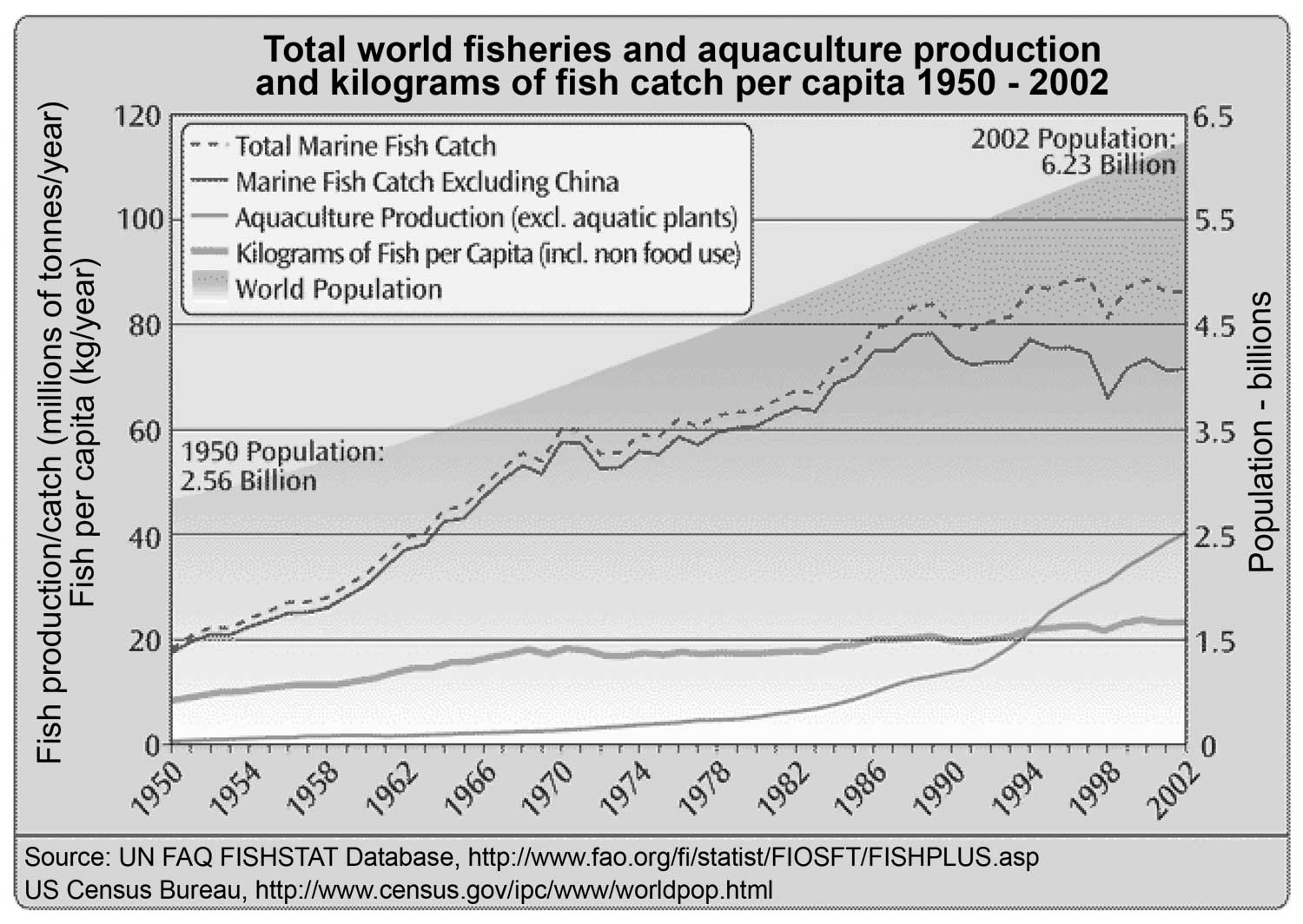
| Previous | Return to table of contents | Search Reports | Next |
| « Back to weltagrarbericht.de | ||
22 | IAASTD Global Report

Figure 1-10. Global capture fisheries and aquaculture production, 1950-2002. Source: FAO, 2007b; US Census Bureau, 2007.
|
million cubic meters, of which 60% was produced in developing countries where wood is the most important source of energy (FAO, 2006d). Forests cover 31% of global land surface (FAO, 2007a) and have potential to provide products and services, hence, could contribute to meeting development and sustainability goals. All types of forests contribute to agriculture in two main ways: (1) the world's forests act as a buffer against climate change, storing 50% carbon in their biomass, deadwood, litter and soil, i.e., more than the amount of carbon dioxide in the atmosphere alone; and (2) they are a principal source of biodiversity. Forests also play a key role in agriculture as the source of much of the land and soils for agriculture. "Slash and burn" agriculture is dependent on forest ecosystems for regeneration of soils, and forests are the source of many types of fruit, meat, timber, fuelwood, medicine, etc. for rural people. Almost a quarter of a billion people live in or near tropical forests, and their well-being depends on them (CIFOR, 2006). Two billion people, a third of the world's population, use fuelwood and charcoal, most of which is harvested in the forest; and two billion people rely on traditional medicines, much of which depends on forest products (CIFOR, 2006). The rapid development of agriculture has proceeded through conversion of natural forests, mainly due to rapid population growth, and the higher food production and cash income that can be obtained from farming rather than from forestry. Deforestation, mainly due to conversion of forests to agricultural land, continues at the rate of 13 million ha per year (FAO, 2005b). The net global change in forest area in 2000-2005 is estimated at -7.3 million ha per year, down from -8.9 million ha per year in 1990-2000 (FAO, 2005b). |
The deforestation trend is increasingly being reversed as forest goods and services are becoming scarce. Changes in cropland show that most of this deforestation has not been for conversion of cropland. Eighty percent of incremental crop production in developing countries by 2030 will come from intensification and only 20% from area expansion (FAO, 2003). The livestock component of agriculture Global livestock production continues to grow more rapidly than crop agriculture, with growth rates of 5% in the 1990s, but has slowed down since 2004 (FAO, 2006a).The volume of livestock production in developing countries has steadily increased since the early 1980s, both for internal consumption and for export (COAG, 2005), driven by rising demand for poultry, pork and eggs as income rises. Livestock production accounts for 40% of the agricultural GDP (FAO, 2006a), produces about one-third of humanity's protein intake, employs 1.3 billion people and creates livelihoods for one billion of the world's poor (Steinfeld et al., 2006). The social and energy benefits of livestock production have long been recognized, as well as its economic contribution outside the formal market system. Women play a key role in small-scale livestock production, and in processing and marketing animal products. Outbreaks of animal diseases, in particular avian influenza, and subsequent consumer fears, trade bans and declines in poultry prices have caused slow growth rates. Livestock production systems also cause environmental problems, with negative impacts on land, climate, water quality and quantity, and biodiversity (FAO, 2006a). As poverty declines, there is predicted to be increased demand |
| Previous | Return to table of contents | Search Reports | Next |
| « Back to weltagrarbericht.de | ||